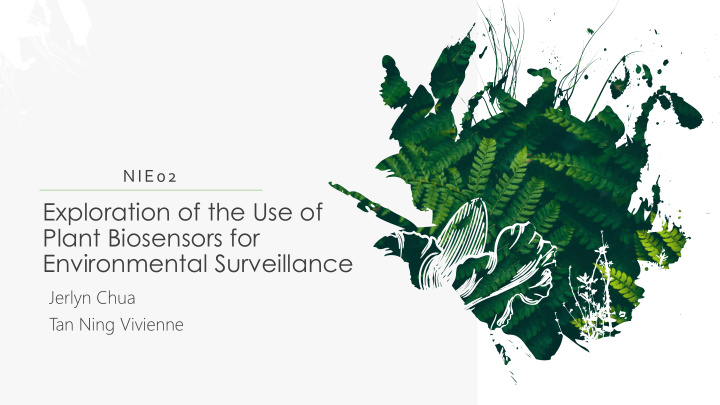



NIE02 Exploration of the Use of Plant Biosensors for Environmental Surveillance Jerlyn Chua T an Ning Vivienne
RATIONALE - Many residents consume vegetables grown in their community gardens without consideration of potential health risks involved. - Singapore hosts numerous petrochemical industries at Jurong Island, putting us in the risk of pollution ALPINE SKI HOUSE
HYPER- ACCUMULATORS - Capable of growing in soils with very high concentrations of metals, sequestering large quantities of heavy metals in their leaves. - Dietary intake of these heavy metals through the consumption of plants have long term detrimental effects on human health ALPINE SKI HOUSE
PLANTS AS BIOSENSORS - Performing holistic environmental surveillance is costly and time consuming - A cheaper and more convenient alternative is to use plants as on site biosensors to monitor environmental quality ALPINE SKI HOUSE
AIM TO INVESTIGATE THE ADDITIVE EFFECT OF HEAVY METALS ON A.THAILANA ALPINE SKI HOUSE
WHY ARABIDOPSIS THALIANA? SIMPLE GENOME NON-HYPERACCUMULATOR - Relatively small genome of - Responds rapidly to approximately 135 megabase environmental stresses with pairs (Mbp) highly noticeable responses - Has its entire genome - Possible to identify potential sequenced hazard sites that are unsuitable for the growth of food plants ALPINE SKI HOUSE ALPINE SKI HOUSE
METHODOLOGY DETERM TERMIN INTATI TION N OF LETHA THAL DOSE , 50% QUANTI TITATIV IVE POL OLYM YMERASE SE OF HEAVY VY METAL CHAIN IN REACT CTION ION (qPCR CR) PLANTIN ING G OF SEEDL DLIN INGS GS After 7 days, the percentage of The fold difference (2ΔCt) was obtained, which A. thaliana seeds were sown dead A.thaliana seedlings was shows the number of times the gene of interest on the MS Mediums calculated and plotted on a expressed relative to the housekeeping gene prepared for 7 days graph to determine the 𝑀𝐸 50 concentration TRE REATME TMENT T WITH TH MIXIN ING G OF HEAVY VY METALS HEAVY VY METALS A. thaliana seedlings were 𝑀𝐸 50 concentration of the 3 transferred to MS Mediums heavy metals were mixed to supplemented with varying investigate the additive concentration of heavy metal effect (As, Pb, Cd) respectively
ANALYSIS OF RESULTS P H E N OT Y P I C C H A N G E S ALPINE SKI HOUSE
OVERALL PHENOTYPIC CHANGES - Steep decrease in height - Whitening of leaves - shows plant death due to inability to photosynthesize ALPINE SKI HOUSE
ANALYSIS - A.thaliana has different 𝑀𝐸 50 HEAVY METAL sensitivities to different heavy CONCENTRATION/uM metals as shown by the As 36 different 𝑀𝐸 50 concentrations Cd 503 - Highest susceptibility towards Pb 2400 As among the three heavy metals studied, followed by Cd and Pb ALPINE SKI HOUSE ALPINE SKI HOUSE
RESULTS 100 90 86 80 72 70 Percentage Dead/% 60 54 52 50 50 50 40 30 20 10 0 As Cd Pb As + Cd As + Pb Cd + Pb ALPINE SKI HOUSE ALPINE SKI HOUSE
ANALYSIS HEAVY METAL(s) PERCENTAGE DEAD/% - For seedlings treated with As 50 As, Pb and Cd respectively, Cd 52 percentage of seedling Pb 54 which died ≈ 50% As + Cd 72 - Generally, those with 2 As + Pb 50 heavy metals show a Cd + Pb 86 higher number of percentage dead ALPINE SKI HOUSE ALPINE SKI HOUSE
ANALYSIS OF RESULTS G E N OT Y P I C C H A N G E S ALPINE SKI HOUSE
ALPINE SKI HOUSE
ALPINE SKI HOUSE
Phytochelatin
RESULTS PCS1 PCS1 - Upregulation of PCS1 gene for seedlings treated 10 with Cd and Pb 5 - Downregulation of PCS1 gene for seedlings 0 treated with As -5 2Δ Ct Ct - Plants is more susceptible to low concentrations -10 of As, as compared to Cd and Pb -15 -20 -25
GLUTATHIONE
RESULTS GSH1 0 - Overall downregulation of GSH1 gene in all -2 samples. -4 - Mutation in the GSH1 gene, which resulted in -6 reduced level of expression of the gene, -8 - Cbf1 proteins bound to the promoter of GSH1, Ct 2Δ Ct -10 preventing transcription -12 -14 -16 -18 -20
RESULTS GSH2 15 - Overall upregulation of GSH2 10 - Glutathione synthetase (GS) catalyzes the synthesis of glutathione 5 - Glutathione protects plants from environmental 0 stresses, oxidative stress, xenobiotics and heavy 2Δ Ct Ct metals -5 -10 -15
CONCLUSION - A.thaliana has different sensitivities to different heavy metals as shown by the different 𝑀𝐸 50 concentrations - Highest susceptibility towards As among the three heavy metals studied, followed by Cd and Pb - The additive effect of heavy metals differ from the effects of individual metals ALPINE SKI HOUSE ALPINE SKI HOUSE
FUTURE WORK - To accurately and fully evaluate Arabidopsis heavy-metal stress tolerance, more standard phenotypic parameters can be measured. - Other more commonly found plants with hypersensitivity to heavy metals can be considered as biosensors in community gardens. - e.g. Spinach (Spinacia oleracea), ALPINE SKI HOUSE ALPINE SKI HOUSE
THANK YOU ALPINE SKI HOUSE
Recommend
More recommend